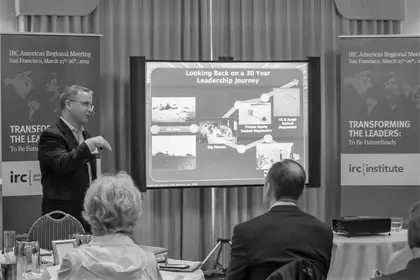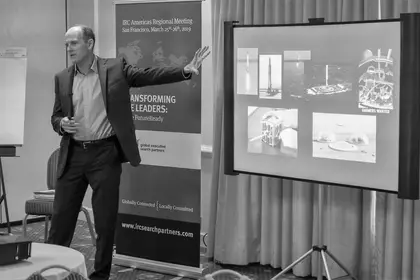Executive Summary
Among the many themes related to uncertainty and making businesses future ready, three dominated the conversation.
- VUCA, an acronym for volatility uncertainty, complexity and ambiguity, is the new normal for business, and leaders must accept this as a fact.
- While being technology savvy is necessary, values and guiding principles are of much greater importance. Leaders must convey a clear vision and sense of purpose, supported by personal integrity.
- Communication is vital, particularly in times of crisis, and it’s a two-way street. Leaders must be clear, honest and transparent in their communications with team members, and never attempt to hide the truth. They must also be careful listeners, taking care to include all points of view, including those they oppose.
DAVID ESPOSITO:
LEADING THROUGH UNCERTAINTY
Guiding Principles
For David Esposito, the first step leaders must take in uncertain times is to acknowledge the new reality faced by all businesses: The world is not going to stay the same. What can and should remain the same in every organization is a core set of guiding principles that the leader instils and nourishes throughout the organization. Central among these principles for staying future ready are teamwork, mutual respect, innovation and trustworthiness.
Clarity
Clarity of intent is also crucial. Esposito cites five central questions that every individual in the organization must be able to answer:
- What is the purpose of the business?
- Why does it matter?
- How do we behave?
- What needs to be done?
- What is my role?
Being clear about the answers to these questions is essential if a business is to thrive in an uncertain future.
Communication in Times of Crisis
There will come times for any business when the whole organization faces uncertainty, and this creates a vacuum and a sense of anxiety that leaders must deal with proactively. One help for managing and staying calm in times of crisis is maintaining the discipline of daily habits.
But the real key is communication. “Get out of the office,” says Esposito, “and talk to people.” What’s important is to be direct, clear, specific and honest. Body language and tone can help, even when all the answers aren’t available.
Points of View
Different points of view are critical in a crisis, and important during calmer times as well because teams tend to get myopic. Esposito uses a sports analogy. “The view of the game on the field is entirely different from the view from the stands, and both are important.” Leaders need to gain understanding about a business from every perspective. Customers are particularly important. Esposito’s own personal experience in building a cancer diagnostics business includes the launch of two successful urology products that were the result of customer suggestions.
David Esposito at the Kestria Americas Summit 2019 in San Francisco
The Stakeholder Paradox
Esposito points out that, in addition to reaching targeted goals, leaders have a responsibility to constantly re-evaluate those goals. Often this involves balancing two competing sets of demands, e.g. meeting 12- or 24-month milestones vs promoting change. Most leaders have made very specific commitments to financial stakeholders, e.g. to deliver product X by date Y. On the other hand, market forces may indicate that re-directing some assets to pursue new initiatives would be wiser in the long run.
Resilience
The mental and emotional toughness to deliver on daily tasks while bouncing back from failure is more essential than ever in these uncertain times.
The Bottom Line
When all is said and done, leadership effectiveness based on these principles is the differentiator that makes companies future ready and enables them to succeed in the face of the unexpected.
STEVE SMITH:
LEADERSHIP AT 17,500 MILES PER HOUR
Steve Smith views leadership from the perspective of a professional explorer. As an astronaut, he worked in an environment of extreme unknowns, surrounded by the vacuum of space, exposed to dangerous radiation, moving at seven to ten times the speed of a bullet with the nearest solid ground some 350 miles below. He points out that all explorers face the same basic conditions: extremely complicated environments that contain massive amounts of information and risk. Like business leaders, explorers have schedules, budgets, stakeholders and competition and, most importantly, must deal with dynamic change when crucial information is missing.
Technical skills certainly play a role in success, but the real key is the attitude. “We start with audacious goals and pursue them relentlessly.” When there are setbacks or failures occur, “We respond immediately. We don’t mope. We innovate quickly, and we come up with timely solutions.”
Smith identifies six characteristics of successful leaders. They are based on common sense and designed to help leaders get the most out of their teams.
1. Authenticity
Leaders need to spend time with the people on their teams on a daily basis and set an example of hard work, dedication and openness to input by being with what Smith refers to as the tribe. “If you do this,” says Smith, “They will follow you.”
2. Clear Vision and Purpose
It’s important that everyone in the organization understands its purpose. This means not only the goal itself but the emotional component of why it’s important and how it’s going to be achieved. “For young people today it’s not the salary and it’s not the location that are important. They want to work for a company that has a purpose.
3. Communication and Transparency
The importance of communication in business has been pointed out again and again, and the key here is not so much frequency as transparency. There are times when leaders need to make difficult decisions or deliver bad news, but if it’s done with openness and honesty, people will accept it and move on.
Steve Smith at the Kestria Americas Summit 2019 in San Francisco
4. Life-Long Learning
Leaders need to have what Stanford professor Carol Dweck refers to as a “growth mindset,” one that drives them to make themselves smarter on a lifelong basis. People aren’t born with everything they need to know. They can always improve and change, often in unexpected ways. One of NASA’s most experienced spacewalkers began his college career as a music major.
5. Inclusiveness
Successful leaders empower everyone on their team and make sure team members have a voice in the decision-making process. People need to feel that they’ve been heard, even if they disagree with a final decision. There should always be room for dissenting views, and they should be voiced.
6. Avoidance of Complacency
Explorers can’t afford to be complacent. NASA needs to continually be looking ahead – the organization is designing spacecraft to go to Mars – and business leaders are also explorers who can’t afford complacency and assume things will go well without constant vigilance.
BUSINESS LEADERS OF THE AMERICAS:
VOICES OF CHANGE
The attendees, senior executives in companies throughout the Americas, played an active role in the summit, offering points of view on three issues: organizational readiness to navigate an uncertain future, the preparation of leaders to be future-ready, and the balance between organizational and individual purpose
The Future-Ready Organization
Ajay Ramachandran, Founding Partner at Happiness Ventures, suggested the typical corporate pyramid should be inverted so that executives are at the bottom — and therefore closest to the customers. There is a potential opportunity to build a trusting relationship with customers by educating them about technology, and especially how their data is being used.
Another aspect of the technology issue relates to governments. They are clearly behind the curve in their understanding of many technologies. This can lead to business opportunities in areas where regulation is still limited, and the cost of compliance is therefore low.
Innovation was the final area of concern. The barriers in this area were identified as “corporate antibodies” — forces resisting change — and the existence of multi-layered chains of command. The greatest success seems to come from isolated innovation units, or in organizations where the chain of command can be bypassed.
The Future-Ready Leader
Two important personal challenges surfaced: the need to be technology-savvy, and the need, as Marc Loupe, a partner in CFOs2GO, put it, “to become a lot wiser,” and abandon the idea that the leader must know everything and personally solve every problem that comes up. Teams must be built so that they’re collaborative and aligned, with talent that’s in sync with company strategy.
Coaching programs for leaders definitely have value, although the experience might be difficult for some.
From a business perspective, becoming customer-centric was seen as a primary challenge. Leaders must make sure that every team member understands this idea in the same way, and must constantly ask themselves what any given activity is doing for the end customer. Finally, when change must come, leaders need to prepare customers in advance and help them understand that new processes and procedures will serve them well.
Aligning Individual and Organizational Perspectives
There was agreement that companies should clearly vocalize the organizational values during the hiring process. Even though people are complex and unique, personal and organizational values can be aligned, yielding higher engagement as the consequence. The idea of replacing the concept of diversity with that of inclusion and equality was also compelling. As the University of California at Berkeley professor, Brian Harman, summarized for his breakout group, “Trust plus conflict equals successful creativity.”
CONCLUSION
The stable, predictable business environment of the past has been replaced by one that has all the complexity and risk of outer space. Success in the uncertain future will require leadership that has its roots in strong personal values, clear goals, and an ability to listen attentively to other voices and communicate clearly and listen attentively to other voices. Hard work will be required, but the rewards are there to be had for leaders who future-proof their business.



